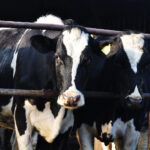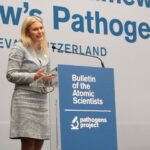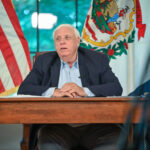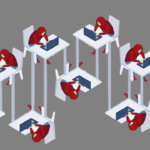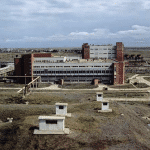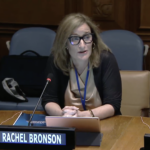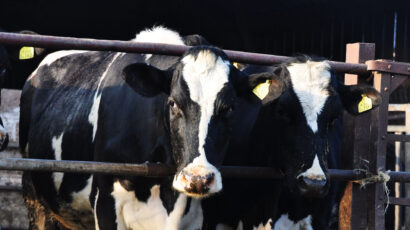Awaiting a decision on new research regulations, scientists pen dueling articles to shape ‘gain-of-function’ policies
By Matt Field | March 23, 2024
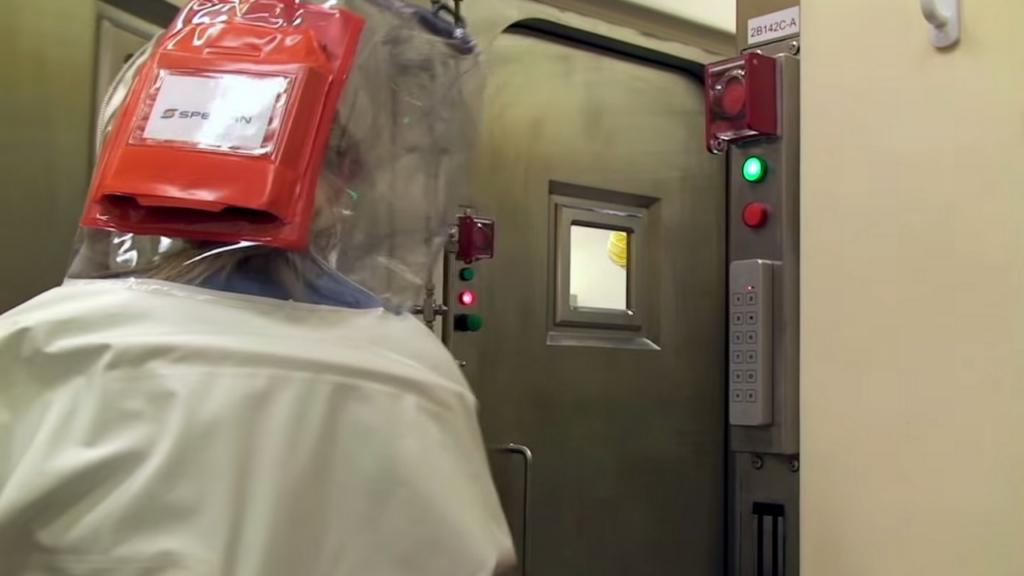 A scientist working in a biosafety level 4 (BSL-4) laboratory. Credit: National Institute of Allergy and Infectious Disease via Wikimedia Commons.
A scientist working in a biosafety level 4 (BSL-4) laboratory. Credit: National Institute of Allergy and Infectious Disease via Wikimedia Commons.
Nearly 14 months have slipped by since an influential group of government science advisors recommended reforming rules governing the funding of US pathogen research. According to the group’s chair, Gerald Parker, that’s too many months. Parker, an associate dean at Texas A&M University, expected quicker action on the proposals to more stringently review experiments that make dangerous viruses more transmissible or virulent, estimating that it should have taken the government about six months to address the recommendations.
As they await a decision on policies for potential pandemic pathogen research, dueling camps of scientists have emerged, weighing in through a journal article, responses to the article, and even responses to the responses. Those camps are seeking to undercut or boost the advisory recommendations developed in the wake of the COVID pandemic—and to bolster or diminish the suspicion that a lab accident could have caused it.
Broadly speaking, the proposed recommendations—put forward by the National Science Advisory Board for Biosecurity, or NSABB—build on current government policy, established in 2017, that calls for a high-level review of research that risks creating potential pandemic pathogens, sometimes called gain-of-function research. Among scientists, the key question is: Will the proposals slow down research important for pandemic preparedness or ensure the adequate vetting of research that could spark a pandemic.
The answer to that question depends, in part, on what research the recommendations would apply to. One camp claims that virology work to enhance a pathogen’s transmissibility or virulence is a vanishingly small part of the virology field—and medically and industrially useless. The recommended policies would improve safety while applying extra review to just few research projects, this group says.
Another camp fears the proposals could touch on a wide swath of virology research, from vaccine development to disease surveillance. If such policies had been in place in 2019, they say, its questionable whether we would have had COVID vaccines in a year.
In a January article in the Journal of Virology, Angela Rasmussen, a virologist at the Vaccine and Infectious Disease Organization at the University of Saskatchewan in Canada, and 77 co-authors painted a picture of an existing and comprehensive web of regulation over virology research in the United States, including federal policies and regulations at the National Institutes of Health (NIH) and elsewhere. The recommendations by the NSABB would unnecessarily deter important work, they say.
Scientists are already shelving work related to vaccines and therapeutics in a climate of uncertainty, the scientists claim. Rasmussen told the Bulletin that several of her colleagues have been instructed to stop work that would not be subject to current policy and that does not meet the definitions of a potential pandemic pathogen “in anticipation of expanding the scope of oversight and due to increased scrutiny of biosafety.”
Current policy covers experiments that create pathogens that are both likely “highly” virulent and transmissible. The new recommendations would also include pathogens that are likely “moderately” virulent or transmissible. The recommendations require that the pathogen proposed for study pose a severe public health threat. They also remove a blanket exemption for vaccine research and disease surveillance.
The advisory recommendations would mean even work on non-pandemic viruses like seasonal influenza would first go through an onerous review before proceeding, Rasmussen and her co-authors say, because the current policy already covers work on the riskiest pathogens. “The [advisory group] recommendations, if adopted as proposed, would sweep much of virology research into new oversight by unnecessarily expanding oversight to pathogens that pose little risk,” the authors say.
But Richard Ebright, a professor of chemistry and chemical biology at Rutgers University who co-authored with 18 others a rebuttal letter this month in the Journal of Virology, disputes that the recommendations would affect much research. By early 2023, when they were issued, only three projects had gone through the existing review process for studies anticipated to create potential pandemic pathogens. The recommendations would apply to up to a dozen current projects, Ebright and his co-authors say. They say lapses in conducting proper review could lead to lab-generated pandemics. There have been many accidents and laboratory-acquired infections in the United States and elsewhere in the past.
The recommendations don’t expand the category of projects that should be reviewed, they just add clarity, Ebright told the Bulletin. “It does go beyond how the [current policy] was interpreted since it was introduced, which was to interpret that there is no such thing as a potential pandemic pathogen, and there certainly isn’t such thing as an enhanced potential pandemic pathogen,” Ebright said.
Rasmussen and her co-authors see ambiguity in the recommendations. She said a broad interpretation of the recommendations could “effectively mean that virtually every experiment involving an infectious viral pathogen would be subject to review.”
But Ebright said it’s clear to scientists what potential pandemic pathogens are; they come from a short list that includes some influenzas, some coronaviruses, and a handful of other organisms. “The grant proposals will say potential pandemic pathogen or pathogen of pandemic potential right in their project summaries or right in their titles,” Ebright said. “Every virologist knows exactly what that includes; every microbiologist knows what that includes.”
NIH, the primary federal funder of biological research, didn’t respond to a request for comment on the status of the advisory recommendations.
Parker, who stressed he was speaking only for himself, said that regardless of whether the Department of Health and Human Services, of which NIH is a part, approves the NSABB proposals, the department should make an implementation plan that describes various responsibilities and gives examples of research that should receive extra scrutiny. The process needs to be efficient, he said, acknowledging that biosecurity and biosafety are unfunded mandates.
In another recent response to Rasmussen’s article, Harvard epidemiologist Marc Lipsitch and three others pointed to efforts in states to ban gain-of-function research on potential pandemic pathogens and “extreme” budget cuts to areas of science. “We interpret these measures, at least in part, as harmful overreactions to what policymakers legitimately perceive as the scientific community’s reluctance to address public concerns about the risks of a laboratory-associated pandemic,” they wrote.
Rasmussen and her colleagues wrote in response, “Broad prohibitions on pathogen research will diminish response capacity at the expense of the American public.”
The sedate back-and-forth in the pages of the Journal of Virology over the potential policy changes masks a fiery and acrimonious debate on social media—one that began with divisions over how the COVID pandemic started four years ago. Rasmussen and some of her colleagues, who’ve participated in research suggesting the pandemic began when the COVID virus leapt from animals to people, recently sent a letter to Rutgers University, where Ebright, who has promoted the so-called “lab leak” theory of pandemic origins, works. They accused him and another colleague of harassment and endangering their safety. They cited posts calling them frauds and liars and comparing scientists to historical mass murderers like Khmer Rouge dictator Pol Pot.
But the researchers who believe it’s possible the COVID pandemic started with a laboratory accident of some sort in China claim they’ve been called plenty of names, too. A molecular biologist at the Broad Institute, Alina Chan, a prominent proponent of the lab leak theory, said she is also a victim.
“Alina has been subjected to more harassment than almost anyone, endangering her, including from highly-credentialed people who constantly complain about harassment,” The New York Times columnist Zeynep Tufekci posted on the X platform.
Efforts to tighten oversight of virology that creates potential pandemic pathogens began over a decade ago, when scientists in Wisconsin and the Netherlands mutated the H5N1 avian influenza virus so it could spread by air among mammals. This led to scientific debates, research moratoriums, and eventually the current NIH project review policies. Despite all this attention, the importance of these experiments can look different in retrospect.
Michael Imperiale, a microbiologist at the University of Michigan, who has written extensively about gain-of-function research, cited hopes at the time of the experiments that they could aid in vaccine development or disease surveillance during a February interview with the Bulletin. “I think to a large degree that those experiments did not provide the types of actionable information that [it was] originally thought they were going to provide back when they were being done,” he said. They did show that H5N1 could evolve to spread in mammals, he said.
Parker, who has long experience working at high levels in US government biodefense operations, including a stint as commander of the US Army Medical Research Institute of Infectious Diseases, said he was at the Department of Health and Human Services and the Defense Department as the debate over the bird flu studies played out. “The results of that work did not change any of our acquisition plans. It didn’t change what we were doing with pre-pandemic H5N1 and our advanced development for a cell-based H5N1 vaccine. It didn’t change anything,” he said.
As far as government pandemic preparedness went, Parker said, they were “interesting studies.”
Together, we make the world safer.
The Bulletin elevates expert voices above the noise. But as an independent nonprofit organization, our operations depend on the support of readers like you. Help us continue to deliver quality journalism that holds leaders accountable. Your support of our work at any level is important. In return, we promise our coverage will be understandable, influential, vigilant, solution-oriented, and fair-minded. Together we can make a difference.
Keywords: COVID-19, NIH
Topics: Biosecurity


